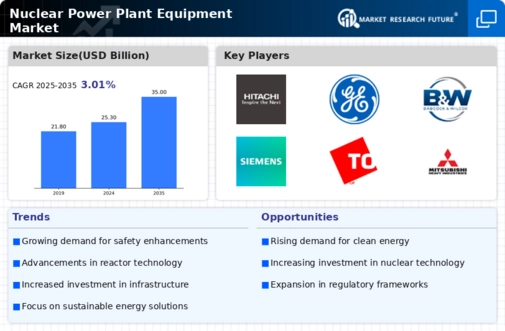Top Industry Leaders in the Nuclear Power Plant Equipment Market

*Disclaimer: List of key companies in no particular order
Top listed global companies in the Nuclear Power Plant Equipment industry are:
General Electric (U.S.)
Alstom (France)
Shanghai Electric (China)
Toshiba Corporation (Japan)
Korea Electric Power Corporation (South Korea)
Larsen & Toubro Limited (India)
Mitsubishi Heavy Industries, LTD. (Japan)
Doosan Corporation (South Korea)
Dongfang Electric Corp., Ltd. (China)
The State Atomic Energy Corporation (India)
BWX Technologies, Inc. (U.S.)
AREVA (France)
Bridging the Gap by Exploring the Competitive Landscape of the Nuclear Power Plant Equipment Top Players
The nuclear power plant equipment market presents a complex and dynamic competitive landscape. Established players fight for dominance, while new entrants seek niches to carve out their share. Understanding the strategies, trends, and key factors influencing market share is crucial for success in this highly specialized industry.
Key Players and Strategies:
- Global Giants: Westinghouse Electric Company, GE Power, Siemens Energy, and Mitsubishi Heavy Industries hold significant market shares. These companies leverage their established brands, extensive product portfolios, and global reach to secure contracts in large-scale projects. Their strategies often focus on technological advancements, cost optimization, and risk mitigation solutions.
- Regional Leaders: Companies like Atomstroyexport (Russia), Korea Electric Power Corporation (KEPCO), and China National Nuclear Corporation (CNNC) command strong positions in their respective regions. They utilize their local expertise, government support, and competitive pricing to compete effectively. Their focus lies on adapting technology to regional needs and cost-effective manufacturing.
- New Entrants: Smaller companies like NuScale Power and TerraPower are emerging with innovative technologies like small modular reactors (SMRs). These offer advantages like flexibility, scalability, and shorter construction times, making them attractive for niche markets and remote locations. Their strategies revolve around rapid technology development, strategic partnerships, and cost-effective deployment models.
Factors for Market Share Analysis:
- Reactor Type: The market is segmented by reactor types like Pressurized Water Reactors (PWRs) and Boiling Water Reactors (BWRs). PWRs dominate the market, but BWRs are gaining traction due to their simpler design and inherent safety features. Players with expertise in specific reactor types hold an advantage.
- Equipment Type: The market can be further divided into island equipment (reactor pressure vessel, steam generators) and auxiliary equipment (turbines, pumps, control systems). Companies with diverse product portfolios catering to different equipment segments can secure larger contracts.
- Geographic Location: The market is driven by regional growth patterns. Asia-Pacific, led by China and India, is the fastest-growing region due to its energy demand and ambitious nuclear power expansion plans. Companies with strong presence in these regions hold an edge.
- Government Policies: Government support through subsidies, financing programs, and regulatory frameworks play a crucial role in market growth. Companies with strong government partnerships and regulatory compliance expertise are better positioned.
New and Emerging Trends:
- Small Modular Reactors (SMRs): The rise of SMRs presents a significant growth opportunity. Their modular design, shorter construction times, and lower capital costs make them attractive for distributed generation and remote locations. Companies investing in SMR technology are well-positioned to capture this emerging market.
- Digitalization and Advanced Automation: The integration of digital technologies and advanced automation systems is transforming the industry. Companies investing in smart sensors, data analytics, and AI-powered solutions for predictive maintenance and operational optimization will gain a competitive edge.
- Sustainability and Waste Management: Concerns about nuclear waste disposal and environmental impact are driving the development of cleaner technologies. Companies with innovative solutions for waste management and fuel recycling will be well-positioned to address these concerns and gain market share.
Overall Competitive Scenario:
The nuclear power plant equipment market is expected to experience moderate growth in the coming years. Competition will remain intense, with established players defending their positions while new entrants seek opportunities in niche markets and innovative technologies. Success will depend on a combination of factors, including technological leadership, regional expertise, cost-effectiveness, and adaptability to changing market dynamics.
In conclusion, the competitive landscape of the nuclear power plant equipment market is characterized by a diverse range of players, each with their own strengths and strategies. Understanding these key players, the factors influencing market share, and the emerging trends is crucial for navigating this complex and dynamic industry. Those who can adapt to changing market demands and invest in innovative solutions will be best positioned to thrive in the years to come.
Latest Company Updates:
Alstom (France):
- December 2023: Alstom signs a contract with EDF to supply steam turbines and generators for the EPR nuclear power plant project in France. (Source: Alstom press release)
Larsen & Toubro Limited (India):
- October 2023: L&T wins a contract from NPCIL to supply steam generators for the Kudankulam Units 5 and 6 nuclear power plants in India. (Source: L&T press release)
BWX Technologies, Inc. (U.S.):
- December 2023: BWXT signs a contract with the U.S. Department of Energy to supply nuclear fuel for advanced reactors. (Source: BWXT press release)

